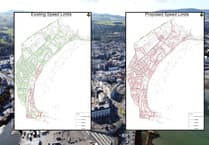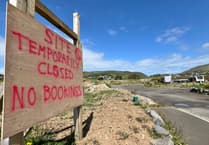Brian King spent 10 years on and off diving the wreck of a 19th century Navy warship.
Now the retired school teacher has written a book about how HMS Racehorse was lost off the coast of the Isle of Man - and how its remains were found on the seabed almost 150 years later.
Brian, 82, has been fascinated by the story of HMS Racehorse for much of his life.
Speaking from his home in Onchan, he said: ‘Diving was my passion. I’ve dived on quite a lot of wrecks.
‘I was always interested in shipwrecks and during the 60s researched the local newspapers and records for known shipwrecks around the Isle of Man.’
The Racehorse, an 18-gun brig-sloop with a crew of more than 100, was on its way from the south of England to Douglas in the winter of 1822 to tow back the Royal Navy cutter Vigilante which had been damaged during a storm in Douglas.
But disaster struck on the night of December 14 when the ship hit the Skerranes rocks off Langness.
A boat and crew from Castletown went to the rescue, but the fourth trip capsized, resulting in the loss of life of three of the rescuers and six crew from the Racehorse.
The efforts of the Manxmen of Castletown to save the lives of 60 sailors proved to be a catalyst in the founding of what became the Royal National Lifeboat Institute, the RNLI.
In 1968, Brian spent a week camping on Langness looking for the wreck but without success.
‘We think we might have found it but didn’t realise it at the time,’ he said.
It was subsequently found by another group of local divers. ‘We returned to the scene within another five weeks to find the shipwreck debris on the seabed.
‘We were obviously very excited,’ said Brian, who has lived in the island for 81 years and was brought up in Port St Mary and Port Erin.
He said he dived the wreck dozens of times.
‘I was diving on it on and off for 10 years with the Isle of Man Sub Aqua Club.
‘It hit the rocks so parts of it are in fairly shallow water but parts go in quite deep where it drops off.
‘With more modern steamers there is often a rusting hill lying around. But being a wooden ship it just rotted away.
‘There is nothing at all to recognise what it is, it is literally debris on the bottom and very little left now having been down there 200 years.
‘You’ve got to really look to find anything.’
He said the excavation was challenging because of the tides and the scattering of the debris on the seabed.
‘We were digging and logging anything we found.
‘We found quite a few artefacts,’ he said.
These together with contemporary newspaper reports and court martial records helped Brian piece together how the Racehorse met its fate.
‘Because it was a Navy ship there was a court martial.
‘If it had been a Merchant Navy ship you would have never got the detail, it would never have been recorded.
‘The ship sank because of pilot error as proved by the court martial.’
Brian has maintained an interest in the history of the Racehorse and has given talks about it to various local groups.
He said: ‘I’ve been recording all this information for many years but I began putting the book together before Christmas.
‘My wife Judy was concerned that all the information that I had spent a lot of time accumulating would just either get mislaid or lost in time so I thought I would put it all in a book and record it for posterity.
‘I enjoyed doing it and it was just time to write a book before I pop my clogs!
‘I couldn’t have done it without Sara [Sara Goodwins of Loaghtan Books]. I had all the facts but she helped me put it all together and put it in context.
‘Obviously the book goes into much more detail which I hope readers will find interesting.’
Meanwhile, time is running out to see Brian’s exhibition of old photos and vintage model yachts detailing the history of Port St Mary model yachting pool.
Model Yachting Mania! is on display at Rushen Heritage Centre, in Bridson Street, Port Erin, until Saturday next week (September 3).
• The Wreck of the Racehorse by Brian King is published by Loaghtan Books and is on sale now price £14.95.




.jpeg?width=209&height=140&crop=209:145,smart&quality=75)
Comments
This article has no comments yet. Be the first to leave a comment.